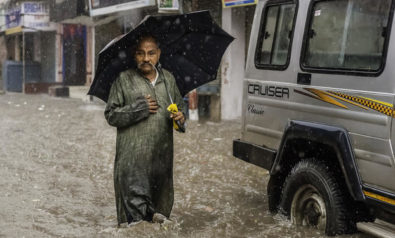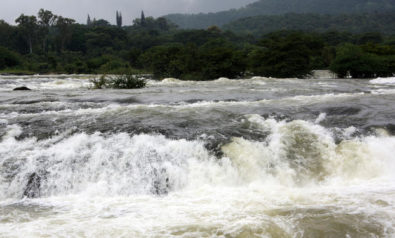The Uttarakhand government is responsible for the destruction caused by recent floods.
The heavy pre-monsoon showers that flooded the upper reaches of the Ganga and Yamuna rivers was India’s biggest natural disaster since the 2004 Indian Ocean Tsunami. “Unfortunate,” was how the National Green Tribunal (NGT) — a court established for the speedy disposal of cases relating to environmental protection — termed the lack of facts in the replies filed by the Environment Ministry, the Utttarakhand government, and other authorities concerned about the action taken to implement its and the Supreme Court’s orders in the wake of recent floods.
“Half of the judicial energy is spent on waking up the government,” the bench headed by former Supreme Court judge and NGT chairperson, Justice Swatanter Kumar said, while directing the environment ministry to “start acting as people’s lives were concerned.”
In the aftermath of the June 16 deluge, people affected and enraged went knocking on the doors of courts in India to seek justice for the gross negligence committed by their government. Writ petitions were filed by environmentalists and lawyers in the Supreme Court for the violation of fundamental rights. A clean and healthy environment is a fundamental right under Article 21 (Right to Life) of the Indian Constitution.
Petitions Before the Supreme Court
First, Swami Achyutanand Tirth filed a writ petition stating that hundreds of decaying bodies were buried in the debris, while some were lying in the open. Further, there may be a possibility of contamination of the Ganga River, a major source of drinking water for several states. The Supreme Court in response ordered the Uttarakhand government to take effective steps to prevent the spread of epidemics in flood-hit areas of the state.
In another writ petition filed by Advocate Ajay Bansal, the Supreme Court directed the National Disaster Management Authority to file a status report on rescue operations carried out by the state. The court also gave direction to the Uttarakhand government regarding free rations and supply of essential commodities to affected families.
August 13 Order of the Supreme Court
On August 13, the Supreme Court passed a blanket order mandating the Ministry of Environment and Forest (MoEF) not to grant any further clearances for hydroelectric power projects in the Himalayan foothills of the state. The court directed the government to constitute an expert body to make a detailed study as to examine the effect of hydroelectric projects in the region. The court cited hydro-electric dams, tunnels, blasting, power-houses, muck disposal, mining and deforestation to be the chief causes behind the June 16 disaster. It ordered the government to make a detailed examination of 24 under-construction projects in the state and file its report with the court. The Supreme Court ordered the Disaster Management Authority in Uttarakhand to submit a report to the court as to why “no disaster management plan existed in the State.” The court's August 13 order came while disposing off a petition by Alakhnanda Hydropower Co. Limited, challenging the Uttarakhand High Court’s order for a public hearing over increasing the height of the dam for producing 330 MW of electricity on the Alakhnanda River.
The Supreme Court’s intervention was indeed welcomed by many in India; however, the order was called into question when the matter came up before the NGT.
Petitions Before the National Green Tribunal
Two petitions are being heard in the NGT as of today. First, a petition filed in the NGT by Khush Naseeb Khan, a resident of Uttarakhand, who alleged that large-scale removal of sand from riverbeds was being carried out without any environmental clearance. On July 2, the NGT, in response to the petition, ordered the Uttarakhand government not to issue any fresh permits for carrying out sand mining in the state. The NGT also sought the response of the state government by the next date of hearing on the operation of sand mining without government clearance. The next hearing is scheduled on September 26.
The second petition was filed by Senior Advocate Raj Panjwani, appearing for the Legal Aid Committee of the NGT Bar Association, as the Uttarakhand government’s conduct in carrying out indiscriminate developmental activities in ecologically fragile regions of the state was challenged. This petition tackles the viability of all developmental projects generally, and hence does not restrict the NGT’s scope of issuing directives only on the basis of one particular aspect like sand mining, hydro-electric projects or rescue operations alone. This case has indeed opened an ugly can of worms for the government.
During the course of legal proceedings, the tribunal issued show-cause notices to the state government and other authorities, including the Central Pollution Control Board (CPCB) and Border Roads Organisation (BRO), stating: “Having been mindful to the damage caused to the ecology and the environment of the state of Uttarakhand, it is a matter which certainly calls for interference by the NGT.” The replies to show-cause notices were not filed on time. In response, the NGT issued a bailable warrant against the Uttarakhand chief secretary, as no one had filed replies or appeared on behalf of the state despite issue of notice.
When replies were finally filed and respondents were mandated to appear before court after arrest and subsequent bail, the bench was hardly pleased. “It is unfortunate that none of the respondents who have filed their replies is in a position to state complete facts of action taken before the Tribunal. The Counsel, appearing for the Uttarakhand government, is not able to state whether the Supreme Court order of August 13 has been implemented or not. Affidavits are also incomplete in terms of our order of July 2,” the bench said.
Orders and Directions of the NGT
The bench, while directing all authorities concerned to expeditiously implement the Supreme Court’s and NGT’s orders, prohibited any construction in the beds and banks of the rivers and their main tributaries flowing in the state. It also restrained construction in the 100 km stretch of the Bhagirathi River, which it declared as an “eco-sensitive zone.” The restrictions would not operate where renovation and reconstruction of legally constructed buildings and houses are concerned, the bench said. Any new construction or project covered by the MoEF’s notification shall follow procedure prescribed by the notification, the bench added.
The Uttarakhand government was directed by the NGT to place a complete and comprehensive list of all illegal construction on the riverbeds, banks and the eco-sensitive zone. The Tribunal also directed the state to submit before it what would be the impact of such construction on the ecology and environment of the area, and what compensation or damages would be imposed upon those responsible for damaging and degrading the environment. The NGT also directed the MoEF to nominate the monitoring committee it was required to constitute as per the SupremeCourt’s orders, and to ensure the panel meets in Uttarakhand within one week thereafter. The monitoring committee is supposed to give clearance to all construction, including renovations that are going to take place in the flood-hit areas of the state.
On September 9, the next scheduled date of hearing, the NGT reprimanded the central government for still not setting up any expert committees for examining the environmental impact of hydro-electric projects and construction works in Uttarakhand. It further slammed a fine of Rs 25,000 on the National Highways Authority of India (NHAI) and the Border Road Organisation (BRO), for failing to file replies as to whether any environmental research was carried out before embarking upon construction works in the state.
During the proceedings, senior advocate Raj Panjwani, appearing for the NGT Bar Association, said: “The floods in the state were a result of the indiscriminate and illegal construction in river beds, banks and the eco-sensitive zone and now there is an opportunity to 're-draw' by keeping in mind the checks and balances required to prevent such an incident from recurring."
The course which the judicial process is taking only confirms the worst fears that were looming large in the minds of the Indian populace. The government is indeed to blame for a lackadaisical attitude towards the environmental impact its developmental policies have. The lives and property lost in the disaster that shook the state only some months ago were a direct consequence of the government’s inactions and omissions. To date, the orders already passed have not been complied with; it is indeed unknown how much of judicial and popular vigilance will be further required to wake up the government out of its long slumber.
The views expressed in this article are the author's own and do not necessarily reflect Fair Observer’s editorial policy.
Image: Copyright © Shutterstock. All Rights Reserved.
Support Fair Observer
We rely on your support for our independence, diversity and quality.
For more than 10 years, Fair Observer has been free, fair and independent. No billionaire owns us, no advertisers control us. We are a reader-supported nonprofit. Unlike many other publications, we keep our content free for readers regardless of where they live or whether they can afford to pay. We have no paywalls and no ads.
In the post-truth era of fake news, echo chambers and filter bubbles, we publish a plurality of perspectives from around the world. Anyone can publish with us, but everyone goes through a rigorous editorial process. So, you get fact-checked, well-reasoned content instead of noise.
We publish 2,500+ voices from 90+ countries. We also conduct education and training programs
on subjects ranging from digital media and journalism to writing and critical thinking. This
doesn’t come cheap. Servers, editors, trainers and web developers cost
money.
Please consider supporting us on a regular basis as a recurring donor or a
sustaining member.
Will you support FO’s journalism?
We rely on your support for our independence, diversity and quality.








Comment